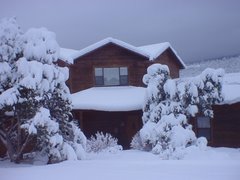Update. Can't believe it. Someone who has written a book on the death of Meriwether Lewis came upon our blog posting on the topic and made a comment. On our way south we stopped Friday morning in
Butte - referred to in the Wikipedia entry as once being the "world's greatest mining town," site of the "world's richest hill." At various stages, gold, silver, and copper have been produced from that hill in great amounts. The
Moon Handbook on Montana, our guide book, says it's Montana's "most representative city." Couldn't pass it up.
Here's a view of the city I found on the web. Nice location, ringed by mountains, scenic valleys radiating out from Butte.

Butte Hill is to the left of this picture. You can see the remaining active copper pit mine at the left of the picture.
We went to the visitor center and caught a trolley (open-air bus) tour. While we were waiting to depart a couple of trolley employees were telling us stories. Said we had a good driver - just completed his parole. Butte was getting ready for its big July 4th parade. Last year, Barack Obama came. They talked about the heightened security and how that clashed with Butte's gun-totin', knife-carryin' way of life. Said they had to take the gun racks out of the trolley.
Our driver (with whom Susie could identify) was a second-grade teacher, working his summer "vacation" to make ends meet. He was a Butte native and after a few summers spent sweeping streets decided that driving a trolley would be more fun.
By the way, Evel Knievel was a Butte native. They have a festival in his honor every summer.
We started at the Berkeley Pit, an abandoned copper pit-mine. It's gradually filling with water (seepage from the surrounding mountains that was pumped out when the mine was operating, but now it is not). The water is about 900 ft. deep, and rising, and is rather contaminated. If it rises much more it will become a threat to the city's water supply, so plans are being made to pump it out, decontaminate it, and pipe it to a suitable site. We're in the middle of some of the world's hottest trout streams, so I'm sure they will be very careful .

Here's the 'headframe' for an old mine. They lowered miners, equipment, and burros down into the mines, and brought up ore, using these structures.
After this mining introduction we drove around on Old Butte streets. Lots of interesting buildings and stories.
In 1917 90,000 people lived on the hill. Now the city, much of which has moved down onto the flats because the Berkeley Pit took a big chunk of town, has a population of 32,000. There were 2000 miles of mine tunnels perforating the hill. Old Butte was a legendarily wild place. Today things seemed deserted. Maybe it was because many businesses and offices were closed July 3.
Butte has a bordello museum. It was open.
Quick! How many dummies in this picture? I had heard that the girls would be butte-nekkid, but at least on the porch, they weren't.
Here's a sampling of Butte buildings, shot from a moving bus.

These identical (miror-image) houses, connected by a breezeway, were built for two sisters.


Somewhere on the itinerary were Teddy Roosevelt's favorite hotel and favorite theater.
The most famous house in Butte is the Copper King Mansion, shown here in a picture I found on the internet (my drive-by attempt was too tilted and off-center).
.jpg)
After all this history and scenery, though, what really got our attention was this:

We've had Grandma's Pasties before, in the Upper Peninsula of Michigan, but we think Nancy topped Grandma. (Our trolley driver pointed out Nancy's to us and we found our way back.) Pasties are miner's food: meat, potatoes, onion, and spices, all in a thick pastry shell -- for eating by hand. Nancy's were huge, swimming in dark brown gravy.
A young couple with a teen-age son came in (the serving area was six stools at a counter). They were from Seattle. Dad said he used to eat pasties at Nancy's every day, 21 years ago. First time back in Butte since then, just had to stop at Nancy's. When the son saw our pasties delivered, he said, Can you get anything smaller? It's as big as a chicken! (I was thinking in terms of a catcher mitt). When our pasties were served, we said, Why didn't we split one? Who knew how big they would be -- for only $6!
After the lad had taken a few bites of his pasty he said, Wow, this was really worth stopping for. (Who says today's youth don't appreciate history.) Kept murmuring his pleasure as he ate.
Nancy's pasties is our commercial gastronomic highlight so far. Given a choice, I'd have to say the walleye that Jeff and Valerie Hinkle served us would be my first choice, overall. And you couldn't beat the price.
Cheers,
Susie and Rob








.jpg)








No comments:
Post a Comment